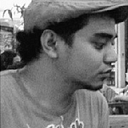Osamu Jinguji: Japan in Flux
Experience Osamu Jinguji’s Japan, where nothing is permanent and everything is in flux. No borders, no boundaries, no visible consciousness.
Some cultures believe that photography makes soul theft possible. Author Ted Grant was even quoted as saying that, “When you photograph people in color, you photograph their clothes. But when you photograph people in black and white, you photograph their souls.” Retired actor/model turned photographer Osamu Jinguji supports the idea but not the idea of criminal superstition, rather the notion of photography as a medium by which a subject is stripped down to its core, bare of any unnecessary layers, of which more important layers may be compounded upon it, revealing more of what we can’t see over what we can. It’s hard to argue with someone who has put so much of his thoughts, of his soul, on his artistic philosophies.
In an age where just about anyone with a camera can take random photos, post them online, and call their work art, Osamu distinguishes himself and his photography with the trappings of existential values and realistic concerns.
On his website, he talks about excising a precise cross-section of time, space, and emotions, all flowing in parallel with other worlds on a subconscious level, a hard notion to digest at first glance for any and everyone who routinely operates on a more conscious basis. Through his photographs, he claims he is imparting his life philosophy, reproducing his intrinsic poetry. His work then should contain bits and pieces of his soul, his memories, which would otherwise be lost, forgotten, as all life continue flowing through an endless cycle, reruns on a mundane Monday night.
It’s hard to argue with someone whose claims you know, feel, to be somewhat true. It’s harder to argue with an output that supports those claims as strong evidence of passion and sincerity. Augmenting the visible with the invisible? Catapulting that tension as infinite? Diluting the barrier between the conscious and the subconscious? Osamu is clearly a complicated individual, more complicated than average, which is to say that we’d get along fine, as fine as I’d be staring at him the entire time, awed at the magnificence of his arguments, my brain and what remains working hard to survive his level of thinking, feeling.
I’ve been to Japan before, to Tokyo in particular, during one winter, when a previous editor of mine goaded me into visiting her but more importantly smuggling homemade bagoong (shrimp paste). In return, she gave me a beautiful tour of a world I’ve only then experienced through anime and manga, a tour filled with heartfelt revelations and an exclusive door to her soul, to her love affair with her adoptive country.
To compare that to a virtual tour of Osamu’s version of Japan, Tokyo, would not be fair. Both have their merits, their advantage over the other, but Osamu’s photographs certainly show a different side of Japan, one that should be no stranger for anyone who’s been in the country, who has even lived there, but did not automatically witness what was beyond the surface.
It’s always either we’re too engrossed with the familiar, with the routine, or we’re too fascinated with ideas, with concepts.
Osamu’s approach is admirable. It’s a great eye-opener, especially for people who get too used to routine, to every single day merging with another, for people like me. It’s reinvigorating, definitely a welcomed, fresh respite from the way of thinking, of seeing things, we’ve all grown accustomed to. It certainly reminded me that beyond the familiar lies a far greater beauty, one that can easily get brushed off, ignored, but should be kept close to heart.
For a much better look at Osamu Jinguji’s modest resistance of the flow of space and time, mingle with Japan’s souls on his website, like his Facebook page, check out his Behance account, and follow him on Tumblr. Your past self will be grateful.
Would you like Parallel Planets to feature your work? Share your black & white planet through us! Our international call for creative contributions is always open — read the complete guidelines and requirements here.

